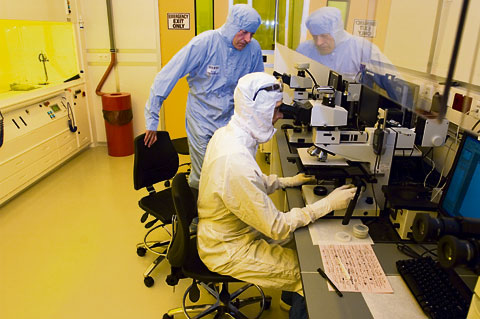One of the largest laboratories for nanotechnology research in Europe lies right here in Delft; TNO’s and TU’s Van Leeuwenhoek Laboratory. It became fully operational last summer.
Yellow illumination in order to protect photo sensitive materials, a vibration-free floor, air with virtually no dust particles, staff wearing protective clothing from head to toe… and yes, in the corner, a handyvac, just in case someone does manage to dirty the place.
Every possible precaution has been taken in the cleanroom that holds the electron beam pattern generator (EBPG), a lithography machine that creates patterns just ten nanometers wide on chips.
This four-million euro machine in TU Delft’s nanotechnology facility runs for 5,000 hours per year. “That corresponds to 13 or 14 hours a day, including New Year’s Eve and Christmas,” says Dr. Emile van der Drift, head of TU Delft’s section of the VLL. “It shows how important this machine is. We are here at the heart of all nanotechnology.”
Seated behind the computer that controls the EBPG are PhD students Georg Goetz and Wei Tang, from the quantum transport section (faculty of Applied Sciences). While Goetz is entering Linux codes to program the EBPG writing process, Tang is making notes on special dust-free cleanroom paper. “It’s really simple”, says Tang. “If you follow the recipe nothing can go wrong.”
The two PhD students are making a chip in order to study the electrical properties of quantum dots defined in carbon nanotubes. They are among the first users of the facility. First they let the lithography machine draw specific patterns with its electron beam on a film-coated silicon chip, and then they remove the exposed regions of the film, turning them into contact electrodes by evaporating metal on them. Finally they use a technique called chemical vapor deposition to grow carbon nanotubes between the contacts.
It’s for fabrication of test instruments – like this quantum dot for example, or nanoscale resonators that oscillate at high frequencies – that researchers, many of whom PhD students, come to this new facility. Van der Drift: “They’re building prototypes of functional nanostructures that will allow them to measure signals from complex phenomena that are hard to interpret.”
About 180 researches from TU Delft are now regularly using the Van Leeuwenhoek Laboratory, which in total consists of 6,000 m2 of laboratory space and 3,000 m2 of cleanroom.
Approximately forty people can work simultaneously in the section reserved for TU Delft researchers, who, previously, had conducted their nanotechnology research in the laboratories of the renowned Delft Institute of Microsystems and Nanoelectronics (Dimes). But 15 to 20 nanoresearchers were the maximum those laboratories could accommodate, so extra space was sorely needed.
Goetz: “Here we have more instruments; for instance an extra electron microscope and extra dry etching machines. And there is more space. Quite an improvement.”
Delta, 30 mei 2002
Volgens Pérez-Ramírez, die in de laatste twee jaar van zijn promotieonderzoek veertig artikelen schreef, is het waarschijnlijk dat zijn katalysator binnenkort in salpeterfabrieken terechtkomt. ”Helaas kan ik dat niet beslissen. Ik verwacht wel dat het voor 2010 zal zijn. Binnenkort moeten fabrieken in Europa die N2O uitstoten belasting betalen. Dat zal de introductie van mijn katalysator versnellen.”
N2O, ook bekend als het bij anesthesisten en feestgangers geliefde lachgas, is niet zo’n onschuldige stof als zijn naam doet vermoeden. De stof, die in belangrijke mate vrijkomt bij de productie van salpeterzuur (een grondstof voor kunstmest) draagt bij aan de afbraak van de ozonlaag en aan de opwarming van de aarde. Het Kyoto-verdrag verplicht landen de uitstoot van het gas te reduceren.
Javier Peréz-Ramirez verbeterde in 2002 bij de vakgroep industrial catalysis (Technische Natuurwetenschappen) een katalysator die lachgas omzet in stikstof en zuurstof. De katalysator bestaat uit zeoliet, een kristallijn poreus materiaal, en ijzerdeeltjes die voor de chemische omzetting zorgen. Peréz-Ramirez zorgde ervoor dat ijzerdeeltjes veel beter verankerd raakten in de zeoliet waardoor de katalysator stukken efficiënter werkte.
De TU was erg te spreken over zijn onderzoek. Hij promoveerde cum laude. Maar zat de industrie ook daadwerkelijk te springen om zijn werk? Pérez-Ramírez, inmiddels hoogleraar aan het Spaanse Institute of Chemical Research of Catalonia, kan een cynisch lachje niet onderdrukken. “Ha, als de TU wat actiever was geweest in het beschermen van haar intellectuele eigendom had ze er goed aan kunnen verdienen. Wat kon ik doen? Ik was maar een arme promovendus. Nu heeft het Duitse chemiebedrijf waar ik tijdens mijn promotie mee samenwerkte veel geld opgestreken. Maar goed, als ik puur vanuit mijzelf redeneer, dan was het wel goed dat de universiteit geen patenten aanvroeg. Daardoor kon ik namelijk ongehinderd wetenschappelijk publiceren.”
Waar zijn katalysatoren terecht zijn gekomen en in welke hoeveelheid, weet Pérez-Ramírez niet precies. Een iets duidelijker beeld heeft hij van de verspreiding van het tweede type lachgaskatalysator dat hij maakte vlak na zijn promotie bij een Noors chemiebedrijf. Wereldwijd maken fabrieken er in een tiental landen gebruik van, zegt hij.
Deze tweede katalysator werkt volgens de TU-alumnus efficiënter. “Maar hij moet in de reactor geplaatst worden, waardoor de investering wat hoger is. Het productieproces van salpeterzuur verandert ook een beetje. Voor de eerste katalysator die ik maakte, hoeft de reactor niet aangepast te worden. Hij werkt ook simpeler. Bedrijven met wat minder chemische expertise gebruiken vooral die eerste katalysator.”
Pérez-Ramírez is naar eigen zeggen uitgegroeid tot een lachgaskatalysatorexpert. “Ik raak inmiddels een beetje verveeld van N2O. Ik moet er altijd maar lezingen over geven op congressen. Maar ik vind het niet meer zo uitdagend. Nu werk ik meer aan katalysatoren voor de petrochemische en de farmaceutische industrie.”



Comments are closed.